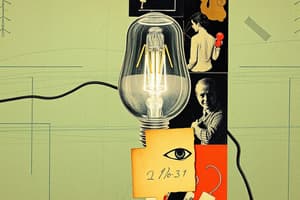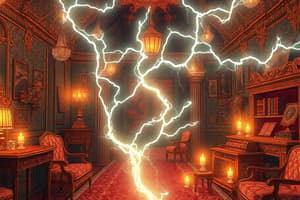Podcast
Questions and Answers
What is the symbol for electrical charge?
What is the symbol for electrical charge?
Q
What is the unit of measurement of charge and its symbol?
What is the unit of measurement of charge and its symbol?
Coulomb, C
What is the number of electrons for one unit of charge?
What is the number of electrons for one unit of charge?
6.28 * 10^18 electrons
Describe static electricity.
Describe static electricity.
Define electrical current.
Define electrical current.
What is the symbol for electric current?
What is the symbol for electric current?
Write an equation to state the relationship between current, charge and time.
Write an equation to state the relationship between current, charge and time.
What is the unit of measurement for electric current and its symbol?
What is the unit of measurement for electric current and its symbol?
Describe conventional current flow.
Describe conventional current flow.
Define voltage.
Define voltage.
What is the name of the force that maintains a voltage?
What is the name of the force that maintains a voltage?
State the abbreviation for this force.
State the abbreviation for this force.
State the unit of measurement for voltage and its symbol.
State the unit of measurement for voltage and its symbol.
State the symbols used to represent source voltage.
State the symbols used to represent source voltage.
State the symbols used to represent voltage drop.
State the symbols used to represent voltage drop.
List six methods of producing an electromotive force.
List six methods of producing an electromotive force.
Define resistance.
Define resistance.
State the unit of measurement for resistance and its symbol.
State the unit of measurement for resistance and its symbol.
State Ohm's law in the form of an equation.
State Ohm's law in the form of an equation.
How is Ohm's law stated?
How is Ohm's law stated?
Define one volt in terms of Ohm's law.
Define one volt in terms of Ohm's law.
Define electric circuit.
Define electric circuit.
Define voltage rise.
Define voltage rise.
Define voltage drop.
Define voltage drop.
Flashcards are hidden until you start studying
Study Notes
Electrical Charge and Current
- The symbol for electrical charge is Q.
- Charge is measured in coulombs (C).
- One unit of charge corresponds to approximately 6.28 x 10^18 electrons.
Static Electricity and Current
- Static electricity refers to the accumulation of charge on an insulated object.
- Electric current is defined as the flow of electrons from a negatively charged point to a positively charged point.
- The symbol for electric current is I.
- The relationship between current (I), charge (Q), and time (t) is expressed as I = Q/t.
Voltage and Electromotive Force
- Voltage indicates an imbalance of electron charges between two points.
- The force maintaining voltage is called electromotive force (emf), abbreviated as emf.
- Voltage is measured in volts (V).
Voltage Representation
- Source voltage is represented by the symbol E.
- Voltage drop is denoted by V with a subscript.
Methods of Producing EMF
- Electromotive force can be produced through several means:
- Magnetic: e.g., generator
- Chemical: e.g., battery
- Friction: e.g., Van de Graaf generator
- Heat: e.g., thermocouple
- Light: e.g., solar cells
- Pressure: e.g., piezo crystal
Resistance and Ohm's Law
- Resistance is a property of materials that opposes electric current flow.
- Resistance is measured in ohms (Ω).
- Ohm’s Law is expressed as I = E/R, indicating that current (I) is directly proportional to emf (E) and inversely proportional to resistance (R).
Understanding Voltage
- One volt is the potential difference required to cause a current of one ampere to flow through a resistance of one ohm.
- An electric circuit is formed when a source of emf is connected to the ends of a conductor.
- Voltage rise refers to the source or applied voltage (emf).
- Voltage drop is the difference in charge observed across the load.
Studying That Suits You
Use AI to generate personalized quizzes and flashcards to suit your learning preferences.




